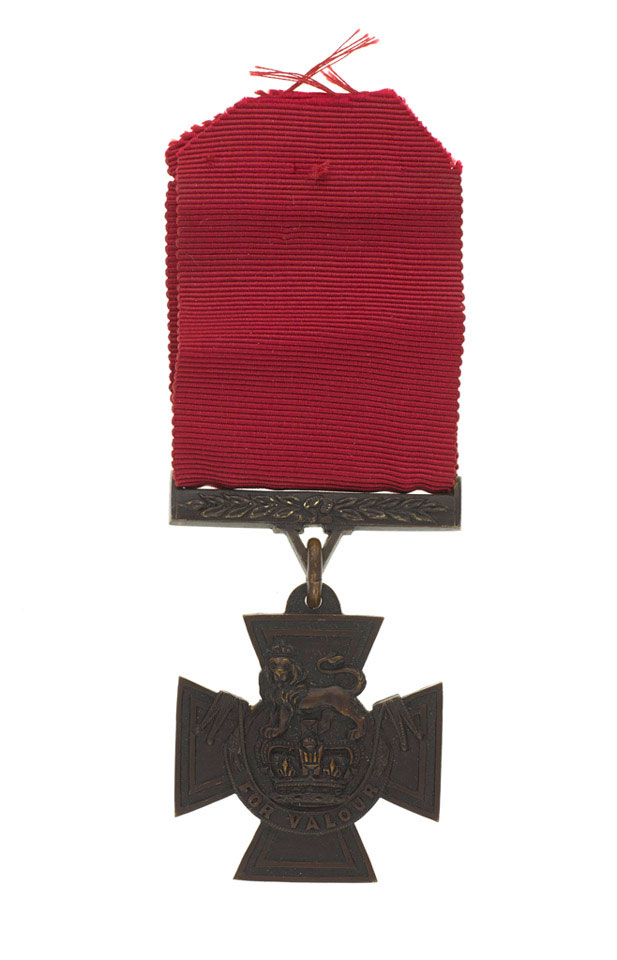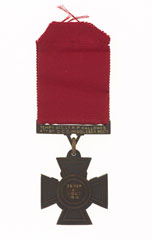
Online Collection
« Prev - 1 of 1 results - Next »
Victoria Cross awarded to Second Lieutenant Rupert Hallowes, 4th Battalion, The Duke of Cambridge's Own (Middlesex Regiment), 1915
Rupert Price Hallowes (1881-1915) was born in Redhill, Surrey, the son of Frederick Blackwood and Mary Ann Taylor Hallowes. Educated at Haileybury College, he later worked for Harold Flower of Gracechurch Street in the City of London. In 1900 Hallowes joined the 20th Middlesex (Artists) Volunteer Rifle Corps. He was commissioned in this unit, re-named the 28th (County of London) Battalion The London Regiment (Artists Rifles) in 1908, on 26 October 1909.
Hallowes resigned his commission in April the following year when he moved to Wales to work for Robert Byass and Co. He was appointed assistant manager of the Mansel Tinplate Works in Aberavon, Port Talbot, where his elder brother William Brabazon Hallowes was the manager. A freemason and assistant secretary of the Boy Scouts Association in Port Talbot, Hallowes lived with his mother in the Dan-y-Ffynnon area of the town.
He re-joined the Artists Rifles in August 1914, quickly being promoted to corporal, lance sergeant and sergeant by the end of September. Hallowes arrived in France on 29 December 1914, and in February 1915 he reverted to the rank of private at his own request. This was probably so that he could be commissioned as the Army was then selecting suitable candidates from the Artists Rifles to replace officer losses in other units.
On 5 April 1915, following training at the Cadet School at Blendecques, St Omer, he was commissioned and joined 4th Battalion The Duke of Cambridge's Own (Middlesex Regiment) a week later. On 19-20 July 1915, during the Battle of Hooge, his unit was serving with the 3rd Division when he was awarded the Military Cross (MC). 'The London Gazette' of 6 September 1915 described how:
'During an enemy attack down a communications trench there was a shortage of bombs. He climbed out of the trench exposing himself to fire at the enemy and hitting several of them. He also assisted in constructing a block, dug out a communications trench under heavy shell fire and rebuilt a parapet that had been blown in. Throughout the night he assisted in keeping touch and supplying bombs'.
Two months later Hallowes was awarded a posthumous Victoria Cross (VC) following another series of actions at Hooge that occurred between 25 and 30 September 1915. According to the citation in 'The London Gazette' of 16 November 1915:
'Second Lieutenant Hallowes displayed throughout these days the greatest bravery and untiring energy, and set a magnificent example to his men during four heavy and prolonged bombardments. On more than one occasion he climbed up on the parapet, utterly regardless of danger, in order to put fresh heart into his men. He made daring reconnaissances of the German positions in our lines. When the supply of bombs was running short he went back under very heavy shell fire and brought up a fresh supply. Even after he was mortally wounded he continued to cheer those around him and to inspire them with fresh courage'.
Hallowes died of his wounds on 30 September, aged 34, and was buried at the Bedford House Commonwealth War Graves Commission Cemetery near Zillebeke.
NAM Accession Number
NAM. 1992-07-1-1
Acknowledgement
Presented by the Trustees of the Middlesex Regimental Museum
Copyright/Ownership
National Army Museum, Out of Copyright
Location
National Army Museum, Study Collection
Object URL
https://collection.nam.ac.uk/detail.php?acc=1992-07-1-1


